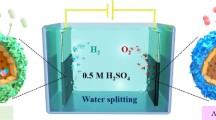Abstract
HCl electrolysis used to manufacture Cl2, a compound of high industrial value, suffers from its high energy requirements. Significant energy savings can be attained by an alternative oxygen depolarized cathode (ODC)-based process where oxygen is reduced at the cathode instead of protons. Though the ODC process is extremely attractive, the state of the art catalysts for oxygen reduction reaction (ORR) suffer from chloride ion poisoning and/or involve toxic chemicals such as hydrogen sulfide (H2S). In the present work, we demonstrate that non-metal containing CNx catalysts do not get deactivated upon exposure to chloride ion environment unlike Pt/C or RhxSy/C where significant chloride ion poisoning was observed. The synthesis of these CNx materials is also extremely facile and scalable. In addition, the performance of the synthesized CNx catalysts was found to be very stable in HCl environment. Thus, the results presented here demonstrate the promise of CNx materials as alternative catalysts for ODC-based HCl electrolysis process to manufacture Cl2 in a sustainable and safer way.
Graphical Abstract





Similar content being viewed by others
References
Moussallem I, Jorissen J, Kunz U, Pinnow S, Turek T (2008) Chlor-alkali electrolysis with oxygen depolarized cathodes: history, present status and future prospects. J Appl Electrochem 38:1177–1194
Gulla AF, Gancs L, Allen RJ, Mukerjee S (2007) Carbon-supported low-loading rhodium sulfide electrocatalysts for oxygen depolarized cathode applications. Appl Catal A 326:227–235
Ziegelbauer JM, Gulla AF, O’Laoire C, Urgeghe C, Allen RJ, Mukerjee S (2007) Chalcogenide electrocatalysts for oxygen-depolarized aqueous hydrochloric acid electrolysis. Electrochim Acta 52:6282–6294
Chlistunoff J (2005) Advanced Chlor-Alkali Technology. Los Alamos National Laboratory, Los Alamos. (Contract No.: LAUR 05-2444)
Amrute AP (2013) Deacon chemistry revisited: new catalysts for chlorine recycling
Schmidt TJ, Paulus UA, Gasteiger HA, Behm RJ (2001) The oxygen reduction reaction on a Pt/carbon fuel cell catalyst in the presence of chloride anions. J Electroanal Chem 508:41–47
Arruda TM, Shyam B, Ziegelbauer JM, Mukerjee S, Ramaker DE (2008) Investigation into the competitive and site-specific nature of anion adsorption on Pt using in situ X-ray absorption spectroscopy. J Phys Chem C 112(46):18087–18097
Ziegelbauer JM, Gatewood D, Gulla AF, Guinel MJF, Ernst F, Ramaker DE et al (2009) Fundamental investigation of oxygen reduction reaction on rhodium sulfide-based chalcogenides. J Phys Chem C 113:6955–6968
Ziegelbauer JM, Murthi VS, O’Laoire C, Gulla AF, Mukerjee S (2008) Electrochemical kinetics and X-ray absorption spectroscopy investigations of select chalcogenide electrocatalysts for oxygen reduction reaction applications. Electrochim Acta 53:5587–5596
Jin C, Xia W, Nagaiah TC, Guo J, Chen X, Li N et al (2010) Rh–RhSx nanoparticles grafted on functionalized carbon nanotubes as catalyst for the oxygen reduction reaction. J Mater Chem 20:736–742
Jin C, Nagaiah TC, Xia W, Bron M, Schuhmann W, Muhler M (2011) Polythiophene-assisted vapor phase synthesis of carbon nanotube-supported rhodium sulfide as oxygen reduction catalyst for HCl electrolysis. ChemSusChem 4:927–930
Jin C, Xia W, Nagaiah TC, Guo J, Chen X, Bron M et al (2009) On the role of the thermal treatment of sulfided Rh/CNT catalysts applied in the oxygen reduction reaction. Electrochim Acta 54:7186–7193
Jin C, Nagaiah TC, Xia W, Spliethoff B, Wang S, Bron M et al (2010) Metal-free and electrocatalytically active nitrogen-doped carbon nanotubes synthesized by coating with polyaniline. Nanoscale 2(6):981–987
Tylus U, Jia Q, Hafiz H, Allen RJ, Barbiellini B, Bansil A et al (2016) Engendering anion immunity in oxygen consuming cathodes based on Fe-Nx electrocatalysts: Spectroscopic and electrochemical advanced characterizations. Appl Catal B 198:318–324
von Deak D, Singh D, King JC, Ozkan US (2012) Use of carbon monoxide and cyanide to probe the active sites on nitrogen-doped carbon catalysts for oxygen reduction. Appl Catal B 113–114:126–133
von Deak D, Singh D, Biddinger EJ, King JC, Bayram B, Miller JT et al (2012) Investigation of sulfur poisoning of CNx oxygen reduction catalysts for PEM fuel cells. J Catal 285(1):145–151
Kramm UI, Lefevre M, Larouche N, Schmeisser D, Dodelet JP (2014) Correlations between mass activity and physicochemical properties of Fe/N/C catalysts for the ORR in PEM fuel cell via Fe-57 mossbauer spectroscopy and other techniques. J Am Chem Soc 136(3):978–985
Kramm UI, Herranz J, Larouche N, Arruda TM, Lefevre M, Jaouen F et al (2012) Structure of the catalytic sites in Fe/N/C-catalysts for O-2-reduction in PEM fuel cells. Phys Chem Chem Phys 14(33):11673–11688
Singh D, Mamtani K, Bruening CR, Miller JT, Ozkan US (2014) Use of H2S to probe the active sites in FeNC catalysts for the oxygen reduction reaction (ORR) in acidic media. ACS Catal 4(10):3454–3462
Lefevre M, Proietti E, Jaouen F, Dodelet JP (2009) Iron-based catalysts with improved oxygen reduction activity in polymer electrolyte fuel cells. Science 324:71–74
Wu G, More KL, Johnston CM, Zelenay P (2011) High-performance electrocatalysts for oxygen reduction derived from polyaniline, iron, and cobalt. Science 332:443–447
Gong K, Du F, Xia Z, Durstock M, Dai L (2009) Nitrogen-doped carbon nanotube arrays with high electrocatalytic activity for oxygen reduction. Science 323:760–764
Guo D, Shibuya R, Akiba C, Saji S, Kondo T, Nakamura J (2016) Active sites of nitrogen-doped carbon materials for oxygen reduction reaction clarified using model catalysts. Science 351(6271):361–365
Acknowledgements
This material is based upon work supported by the U.S. Department of Energy, Office of Science, Office of Basic Energy Sciences under Award Number DE-FG02-07ER15896.
Author information
Authors and Affiliations
Corresponding author
Ethics declarations
Conflict of interest
All contributing authors certify that they have NO affiliations with or involvement in any organization or entity with any financial or non-financial interest in the subject matter contained in this manuscript.
Rights and permissions
About this article
Cite this article
Mamtani, K., Jain, D., Co, A.C. et al. Investigation of Chloride Poisoning Resistance for Nitrogen-Doped Carbon Nanostructures as Oxygen Depolarized Cathode Catalysts in Acidic Media. Catal Lett 147, 2903–2909 (2017). https://doi.org/10.1007/s10562-017-2205-3
Received:
Accepted:
Published:
Issue Date:
DOI: https://doi.org/10.1007/s10562-017-2205-3




